 W
WThe Basilica of Nuestra Señora de Soledad is a Roman Catholic Basilica located in Oaxaca de Juárez, Oaxaca, Mexico. It was built between 1682 and 1690, and is a sanctuary dedicated to Our Lady of Solitude, patron saint of Oaxaca. The architecture style is Baroque, and was intentionally built with low spires and towers, as to better resist earthquakes. The Basilica de la Soledad is part of the Historic Center of Oaxaca City, which was declared World Heritage Site by UNESCO in 1987.
 W
WThe Basilica of Our Lady of Zapopan and the abbey of Our Lady of Expectation of Zapopan are a 17th-century Franciscan sanctuary built in downtown Zapopan, in the state of Jalisco, México.
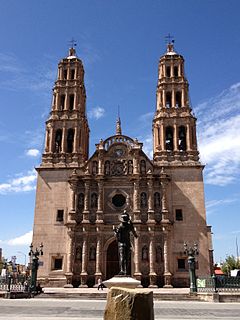 W
WThe Metropolitan Cathedral Church of the Holy Cross, Our Lady of Regla, and St Francis of Assisi is the main ecclesiastical building of the Catholic Church in Chihuahua City, Chihuahua, Mexico. It is considered perhaps the finest example of colonial architecture in northern Mexico and it was built between 1725-1792. The cathedral is also the seat of the Roman Catholic Archdiocese of Chihuahua. As of 2013 the archbishop was Constancio Miranda Weckmann.
 W
WThe Parroquia de Santa Prisca y San Sebastían, commonly known as the Church of Santa Prisca, is a colonial monument located in the city of Taxco de Alarcón, in the southern state of Guerrero, Mexico, built between 1751 and 1758. It is located on the east side of the main plaza of Taxco.
 W
WThe Church and former monastery of Santo Domingo de Guzmán is a Baroque ecclesiastical building complex in Oaxaca, Oaxaca, Mexico. The complex includes a substantial sanctuary and an extensive system of courtyards, cloisters and rooms that formerly constituted the monastery.
 W
WThe Convent of San Francisco is located at the western end of Madero Street in the historic center of Mexico City, near the Torre Latinoamericana and is all that remains of the church and monastery complex. This complex was the headquarters of the first twelve Franciscan friars headed by Martín de Valencia who came to Mexico after receiving the first authorization from the Pope to evangelize in New Spain. In the early colonial period, this was one of the largest and most influential monasteries in Mexico City. It was built on the site of where Moctezuma II’s zoo once was. At its peak, the church and monastery covered the blocks now bordered by Bolivar, Madero, Eje Central and Venustiano Carranza Streets, for a total area of 32,224 square meters.
 W
WThe Corpus Christi Church is a former church on Avenida Juárez in the Historic center of Mexico City. It is the only remaining part of the Convent of Corpus Christi, founded in 1724 for Indian women and which was closed as part of the Reform Laws. The architect of the baroque structure was Pedro de Arrieta who also designed the Palace of the Inquisition and the Church of San Felipe Neri "La Profesa".
 W
WThe Cuernavaca Cathedral is the Roman Catholic church of the Diocese of Cuernavaca, located in the city of Cuernavaca, Morelos, Mexico. The church and its surrounding monastery is one of the early 16th century monasteries in the vicinity of the Popocatepetl volcano, built initially for evangelization efforts of indigenous people after the Spanish conquest of the Aztec Empire. By the 18th century, the church of the monastery began to function as the parish church of the city and in the late 19th century, it was elevated to the rank of a cathedral. Unlike many cathedrals in Mexico, this one does not face the city's main square, but rather is located just to the south, in its own walled compound, which it shares with a number of other structures. Unlike the other monastery structures from its time, the importance of this church provoked a number of renovation projects, the last of which occurred in 1957. This one took out the remaining older decorations of the interior and replaced them with simple modern ones. This renovation work also uncovered a 17th-century mural that covers 400 square metres (4,300 sq ft) of the interior walls and narrates the story of Philip of Jesus and twenty three other missionaries who were crucified in Japan.
 W
WDesierto de los Leones National Park is located entirely within the limits of the Federal District; it stretches between Cuajimalpa and Álvaro Obregón boroughs. It is located in the Sierra de las Cruces mountain range west of the city center with an area of 1,867 hectares, representing fifteen percent of the entire Valley of Mexico. The term Desierto (‘desert’) is used in this context in the archaic sense of “wild, sparsely populated area” rather than in reference to an arid environment. Leones (‘Lions’) refers not to the big cats but rather to the original landlord's surname.
 W
WEl Carmen is a former convent converted to museum in San Ángel, a southern suburb of Mexico City.
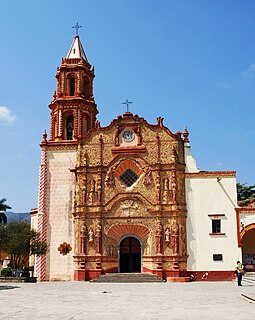 W
WThe Franciscan Missions of the Sierra Gorda in the Mexican state of Querétaro were declared a World Heritage Site by the UNESCO in 2003. They are credited to Junípero Serra of the Franciscan Order, who also founded important missions in Alta California.
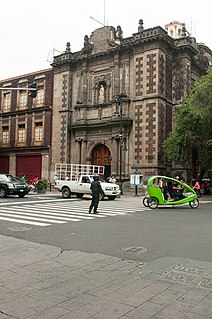 W
WThe Church of San Bernardo stands at the corner of Avenida 20 de Noviembre and Venustiano Carranza Street just south of the Zocalo or main plaza of Mexico City. It was part of a convent of the same name that was founded in 1636, but was closed along with all convents and monasteries during the La Reforma period in 1861. Currently, only the church remains of the convent complex.
 W
WMIDE, Interactive Museum of Economics or simply MIDE is the first museum in the world dedicated exclusively to economics. The museum was opened in 2006 and is located on Tacuba Street in the historic center of Mexico City. The museum is open to the public and features hands-on exhibits meant to make the basic concepts of economics fun and engaging. The museum is housed in the old Bethlehemite convent and hospital. Before the Bank of Mexico acquired the building in 1990, it was in ruins and filled with debris. It took fifteen years to restore the building to what it probably looked like in the 19th century.
 W
WLa Enseñanza Church (1772-1778) is located on 104 Donceles Street in the historic center of Mexico City. The Mexican Churrigueresque style of this church, especially that of its altarpieces, is upheld as the pinnacle of the Baroque period in Mexico, as this style soon gave way to the Neoclassic shortly after this church was built. The church’s official name is Iglesia de Nuestra Señora del Pilar. The former convent was called El Convento de la Enseñanza La Antigua, from which is derived the church’s popular name. After the Reform War, the convent was disbanded. The complex has had various uses, but the church has been returned to its sacred function.
 W
WLa Santísima Church is located 12 La Santísima Street at corner of Emiliano Zapata Street in the historic center of Mexico City. Its full name is Church and Hospital of the Most Holy Trinity. The church was built between 1755 and 1783 as a temple for the adjoining hospital/hospice for priests. The hospital functioned until 1859, when the Reform Laws nationalized much of Church's property in Mexico. The church still retains its original function but the adjoining hospital and office sites have since moved into private hands with only parts of the original structures still intact and preserved.
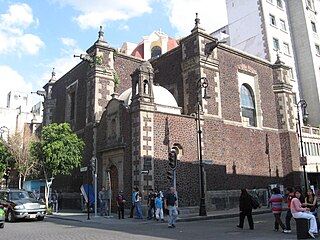 W
WThe Library of the Congress of Mexico mostly contains the records of the country's legislative sessions since its Independence. It is located at 29 Tacuba Street, near the corner with Bolivar in the historic center of Mexico City. This structure was originally part of a Poor Clares convent founded in the 16th century, but was confiscated by the Reform Laws of the 19th century. Since then, this building has been used as government offices, barracks and even a canteen. It current use was established in 1962, when the Library of Congress was founded by the Mexican government. Since then, the archives it houses have outgrown the building and a number are housed at the Palacio Legislativo de San Lázaro as well.
 W
WThe Metropolitan Cathedral of the Assumption of the Most Blessed Virgin Mary into Heaven is the seat of the Catholic Archdiocese of Mexico. It is situated atop the former Aztec sacred precinct near the Templo Mayor on the northern side of the Plaza de la Constitución (Zócalo) in Downtown Mexico City. The cathedral was built in sections from 1573 to 1813 around the original church that was constructed soon after the Spanish conquest of Tenochtitlan, eventually replacing it entirely. Spanish architect Claudio de Arciniega planned the construction, drawing inspiration from Gothic cathedrals in Spain.
 W
WCathedral of Morelia is a Baroque-style, Roman Catholic cathedral located in the center of the city of Morelia, Michoacán, Mexico. It is the seat of the Roman Catholic Archdiocese of Morelia.
 W
WThe Museo Nacional de las Intervenciones is located in the former Monastery of San Diego Churubusco, which was built on top of an Aztec shrine. The museum is split into two sections. The downstairs is dedicated to the site’s history as a monastery, and the upstairs rooms are dedicated to artifacts related to the various military conflicts that have taken place on Mexican soil and how these have shaped the modern Mexican republic. The museum is located on Calle 20 de Agosto, one block east from Division del Norte, following Calle Xicoténcatl, in Churubusco. It is one of five museums that are operated directly by the Instituto Nacional de Antropología e Historia (INAH).
 W
WThe Cathedral of Our Lady of the Assumption, located in the city of Oaxaca de Juarez, Oaxaca, Mexico, is the seat of the Roman Catholic Archdiocese of Antequera, Oaxaca. Its construction began in 1535 and it was consecrated on 12 July 1733. It is dedicated to Our Lady of the Assumption.
 W
WOur Lady of Solitude Cathedral, also called Irapuato Cathedral, is the main Roman Catholic temple in Irapuato, Mexico. It is located in front of the Plaza Monumental Miguel Hidalgo. It is the mother church of the diocese of Irapuato, which is the seat of the bishopric.
 W
WThe St. Philip Neri Cathedral Also Querétaro Cathedral It is a Catholic church that was built by the felipense order. It is located in the center of the city of Santiago de Querétaro in Mexico.
 W
WThe Sanctuary of Atotonilco is a church complex and part of a World Heritage Site, designated along with nearby San Miguel de Allende, Guanajuato, Mexico. The complex was built in the 17th century by Father Luis Felipe Neri de Alfaro, who, according to tradition, was called upon by a vision of Jesus with a crown of thorns on his head with blood on his face and carrying a cross. The main feature of the complex is the rich Mexican Baroque mural work that adorns the main nave and chapels. This was chiefly the work of Antonio Martínez de Pocasangre over a period of thirty years. The mural work has led the complex to be dubbed the "Sistine Chapel of Mexico." The complex remains a place of worship and penance to this day, attracting as many as 5,000 visitors every week.
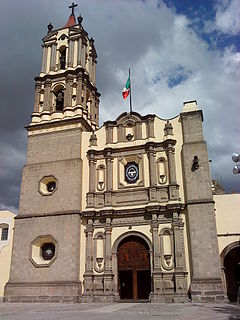 W
WThe St. Bonaventure Cathedral Also Cuautitlán Cathedral is a Catholic temple, part of the convent of the same name in the Municipality of Cuautitlán, State of Mexico. It was designated as a cathedral on February 5, 1979 with the erection of the diocese of Cuautitlán.
 W
WThe St. James Cathedral Also Saltillo Cathedral Is the catholic cathedral of the city of Saltillo in Mexico. It is located in the historical center of the city, opposite the Plaza de Armas, is one of the architectural jewels of the state of Coahuila. It is the tallest cathedral in the north of Mexico, and one of the highest in the country.
 W
WThe Church of San Felipe Neri, commonly known as "La Profesa", is a Roman Catholic parish church that was established by the Society of Jesus late in the 16th century as the church of a community of professed Jesuits. The church is considered to be an important transitional work between the more sober or moderate Baroque style of the 17th century and the extremely decorated manifestations of the Baroque of the 18th century in Mexico.
 W
WThe Temple of Saint Anthony of Padua is a Catholic church and monument in the center of Aguascalientes City, Mexico. The church was designed by José Refugio Reyes Rivas (es). The church was originally commissioned by the Order of Saint Francis and is currently managed by the Order of Saint Augustine.
 W
WThe Cathedral of Our Lady of Valvanera is located southeast of the main plaza, or Zocalo, of Mexico City on the corner of Correo Mayor and Republica de Uruguay in the historic center. The church originally belonged to the Convent of Santo Niño Perdido which was founded in 1573. This would then become a Conceptionist convent in the 17th century, when the church and convent were rebuilt in 1667. It also gained its current name at that time.
 W
WXalapa Cathedral or in full, Catedral Metropolitana de la Immaculada Concepción de Xalapa is a Roman Catholic cathedral in the city of Xalapa, Veracruz, in eastern Mexico. The see of the Metropolitan Archdiocese of Xalapa, it is one of the oldest constructions of the city.